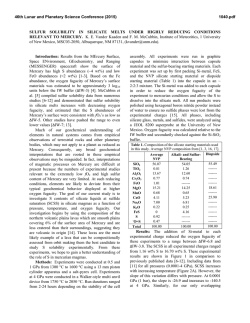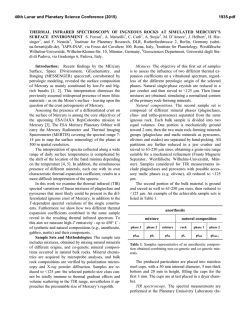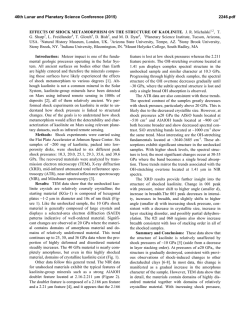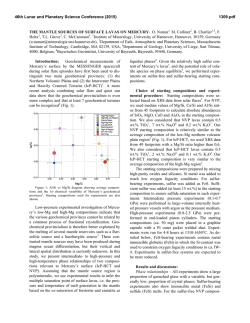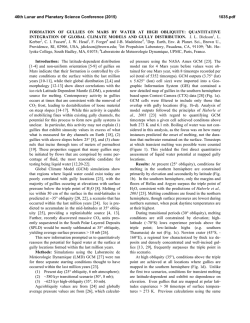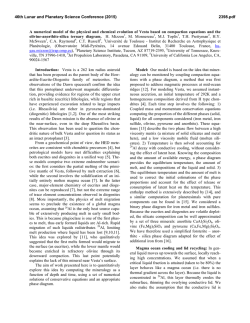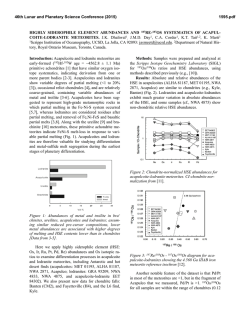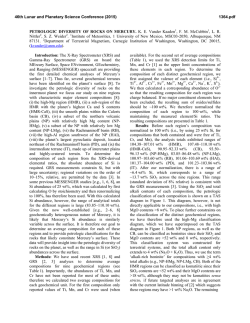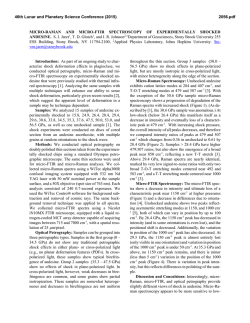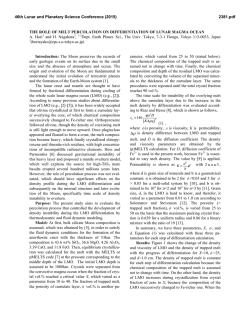
role of sulfur, silicon and carbon on the crystallization processes in
46th Lunar and Planetary Science Conference (2015) 2627.pdf ROLE OF SULFUR, SILICON AND CARBON ON THE CRYSTALLIZATION PROCESSES IN MERCURY’S CORE INFERRED FROM IN-SITU MELTING EXPERIMENTS BETWEEN 4.5 AND 15.5 GPA. A. M. Martin1, J. Van Orman1, S. A. Hauck, II1, N. Sun1, T. Yu2 and Y. Wang2, 1Case Western Reserve University, 10900 Euclid Avenue, Cleveland OH 44106 USA ([email protected]), 2University of Chicago, GSECARS, Argonne National Laboratory, 9700 South Cass Avenue, Argonne IL 60439 USA. Introduction: The formation and evolution of Mercury’s large metallic core is poorly understood. Based on the evolution of the melting temperature as a function of pressure in the Fe-S system, a top-down crystallization processes (iron “snow”) has been suggested, which does not occur in larger terrestrial planets like the Earth [1-3]. In order to test this atypical process in a system that is likely to be closer to a natural core composition, we recently constrained the eutectic melting temperature in the Fe-FeS-Fe3C system, which we found to be very low (800-900°C) between 4.5 and 24 GPa [4] (Figure 1). Recent results from the MESSENGER mission indicate extremely reducing conditions in Mercury, under which a substantial amount of silicon should also dissolve into the core [5]. The presence of Si could significantly modify the chemical and physical properties of Mercury’s core (e.g., phase relations, crystallization, and density). According to [5-7], the liquidus in the 74 wt.% Fe - 18 wt.% S - 8 wt.% Si system is located at ~1800°C at 15 GPa, increasing to 2000°C above 25 GPa. By extrapolation, they suggest that the liquidus is located above 1600°C at the pressure of Mercury’s core/mantle boundary (5-7 GPa). The solidus temperature is estimated to be around 1450°C at 20 GPa [6]. No data are available on the liquidus and solidus temperatures below 15 GPa. [8] observed melting above 1200°C at 5 and 10 GPa in the 87.81 wt.% Fe – 14.62 wt.% S – 4.62 wt.% Si – 0.99 wt.% C system; however, they did not constrain the liquidus and solidus temperature. In order to test the iron snow hypothesis in a system that takes into account sulfur, silicon and carbon, we performed in-situ high-pressure, high-temperature experiments in the Fe-FeS-Fe2Si-Fe3C system using a multi-anvil press on a synchrotron. Our experiments allow us to constrain the eutectic melting temperature as a function of pressure and to determine melt compositions, and provide a basis to build a complete phase diagram that can be used to model Mercury’s core crystallization. Experimental method: In order to observe low degree eutectic melting, we separated the samples into two parts: (1) an iron rod presaturated with Si and C and (2) a mixture of FeS, Fe2Si and Fe3C. Eutectic melting temperature and phase relations were determined at various pressures between 4.5 and 15.5 GPa using a 1000-ton mutli-anvil apparatus at the Advanced Photon Source, Argonne (13-IDD). A 10/5 (octahedron edge length / WC cubes TEL) assembly was used for all the experiments. The sample was placed in a BN capsule plugged by BN powder. Temperature was measured using a W5Re95-W74Re26 thermocouple crossed at one end of the sample. Pressure calibrations were made during each experiment using a MgO pressure marker. A cylindrical rhenium foil was used as furnace. It was separated from the MgO octahedron using a LaCrO3 insulating sleeve. In addition, graphite windows were inserted into the Re furnace and LaCrO3 sleeve on the X-ray beam path. During the experiments, the pressure was first increased to the desired value. Then, the temperature was increased by increments in order to regularly take X-ray images and diffraction spectra of the sample. Temperature was quenched soon after the melting was observed, so that eutectic melting textures would be preserved. Figure 1: Pressure – temperature diagram showing the eutectic melting curve in the Fe-S-Si-C system (this study) compared to the Fe-S-C system [4]. Previous studies on the Fe-S-C [8, 9], Fe-S-Si [6], Fe-S [1] and Fe-Fe3C [10] systems from the literature are reported for comparison. Analyses: Energy dispersive X-Ray diffraction spectra were collected for 300s at various stages during the experiments. 2-θ was calibrated at ambient pressure during each experiment. Spectra of MgO were fitted using [11]. X-ray images were also taken at various stages in order to observe the decrease of con- 46th Lunar and Planetary Science Conference (2015) trast between the two parts of the sample that occurs when the melting temperature is reached. After the experiments, the recovered samples were mounted in epoxy resin, ground to the longitudinal mid-section and polished using Al2O3 powder. Back-scattered electron images and quantitative analyses were performed using an energy dispersive spectrometer and a silicon drift detector on a FEI Nova Nanolab 200 Scanning Electron Microscope. The standards used for Fe, S, C, Si and O were iron Fe, iron sulfide FeS, iron carbide Fe3C, quartz SiO2 and alumina Al2O3, respectively. Figure 2: Back-scattered electron images of the FeSrich melt (left) and FeSi-rich melt (right) textures. Results: The X-ray images, diffraction spectra and back-scattered electron images of the recovered samples show that the eutectic melting occurs around 800 900°C between 4.5 and 15.5 GPa. Immiscibility between a FeS-rich melt and a FeSi-rich melt is observed in the recovered samples (Figure 2). FeSi-rich melt is present in all the samples below 12 GPa, while FeSrich melt forms up to at least 15.5 GPa. This lower stability pressure of the FeSi-rich melt is in agreement with the phase diagram in the Fe-S-Si system [5]. Analysis of the immiscible melts indicates that C preferentially partitions into the FeSi-rich melt, rather than in the FeS-rich melt (Figure 3). Solid Fe, FeS, Fe3Si and Fe3C are also present in all the samples. Discussion: The eutectic melting temperatures determined in this study are close to the eutectic temperatures in the Fe-FeS-Fe3C system, indicating that Si does not influence the eutectic temperatures significantly. Melting therefore occurs at much lower temperature than suggested for the Fe-S-Si [5] system at similar pressures. This difference may be explained by the presence of C in the samples. It is also possible that the eutectic temperature is overestimated significantly in quench experiments; our experimental setup may be more suitable for detecting the low degrees of melting in metallic systems. 2627.pdf Figure 3: Ternary diagrams showing the Fe, S, Si and C contents (at%) in the FeSi-rich melts (red) and FeSrich melts (pink) formed in the Fe-S-Si-C system (this study), compared to the FeS-rich melt formed in Fe-SC system (blue) from [4]. The cotectic curves determined by [8] are also reported for comparison. Implications for Mercury’s core: The variations of eutectic melting temperature observed by [2] in the Fe-S system are not observed in the presence of C and Si. However, the eutectic melting temperature is systematically lower, and it slightly decreases when pressure increases (Figure 1). This slightly negative eutectic melting temperature gradient with pressure implies that an iron “snow” process may be important if sulfur, silicon and carbon are all alloyed with Fe in Mercury’s core. Furthermore, the low melting temperatures in the Fe-S-Si-C system may also aid in maintaining a substantial liquid portion of Mercury’s core to the present and in limiting the amount of global contraction [12] that is due to solidification of the core [13, 14]. References: [1] Chen et al. (2008) GRL, 35, L07201 [2] Chen et al. (2008) High Press. Res., 28, 315-326 [3] Dumberry and Rivoldini (2015) Icarus, 248, 254-268 [4] Martin et al. (2014) LPSC XLV, Abstract # 2854 [5] Malavergne et al. (2010) Icarus, 206, 199-209 [6] Sanloup and Fei (2004) PEPI, 143-144, 421-432[7] Siebert et al. (2004) [8] Deng et al. (2013) GCA, 114, 220-233 [9] Dasgupta et al. (2009) GCA, 73, 6678-6691 [10] Nakajima et al. (2009) Phys. Earth Planet. Mat., 174, 202-211 [11] Speziale et al. (2001) JGR, 106, 515-528. [12] Byrne at al. (2014) Nature Geosci., 7, 301-307 [13] Tosi et al. (2013) JGR Planets, 118, 2474-2487 [14] Hauck et al. (2004) EPSL, 222, 713-728.
© Copyright 2024
